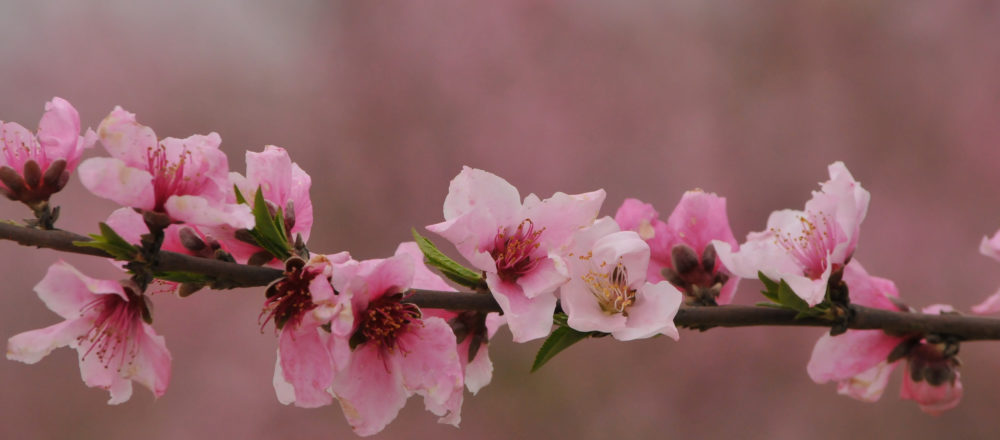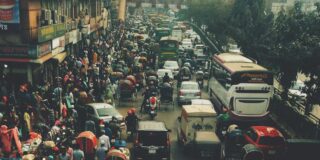10 minute read
If driving into the regional Victorian city of Shepparton from the east, it is difficult to find a route that doesn’t take you through a corridor of fruit orchards. Resembling a low-rise forest, the fruit trees stand in perfect rows, their branches reaching out into the country air, changing as they adapt to the seasons. Woody and skeletal in winter, wearing glamorous coats of blossom in spring, and shading the ground below with large emerald-green leaves in summer before shedding these in the autumn. Apple trees, pear trees, apricot trees and peach trees. While the exact origin of these plants has been debated in the past, they aren’t native to Australia. They aren’t from here.
The botanical name for peaches is prunus persica, making reference to Persia, or as we know it today, Iran. A country with one of the largest Muslim populations in the world. While the roots of peach trees clutch the Australian soil far from where their ancestors grew, they have prospered and helped to sustain a city, a region, and a country, for decades. In that way, the trees are similar to the white settlers who came to Yorta Yorta country to start a new life and future, and similar to the recent refugees from Afghanistan, Iraq, Congo and other countries, who now call Shepparton home.
To flourish in a foreign land, Shepparton’s first peach trees needed well-prepared soil, fresh water, bright sunshine, and to be planted with care so their roots could establish. In the years since, the way in which the peach tree orchards have been nurtured has been adapted, refined, and improved. Just as wisdom about orchards has been passed down between generations of horticulturalists for centuries, regional cities and towns around Australia can learn from Shepparton, and places like it, in the current debates over Muslim immigration, and discussions about the future of rural and regional areas.
I grew up in the Goulburn Valley and went to high school in Shepparton. Each morning and afternoon the school bus would shuttle me past these orchards of foreign trees, now firmly at home.
White “Aussie” kids dominated my school’s population of around 1000 students but not everyone was the same. The school had Aboriginal, Italian, Greek and Albanian kids. There were Christian evangelical kids who weren’t allowed to watch classroom videos. Kids in electric wheelchairs cruised the courtyard. At lunchtimes, a boy with Down Syndrome would put on a WW1 soldier helmet and play, making machine gun noises in his agapanthus war field. I watched the tummy of a girl grow throughout the year, and later heard how she delivered her baby the day the post office delivered her exam results. Parents at the school included doctors, lawyers, taxi drivers and sex workers. Diversity and difference was all around. Yes, there were bullying incidents and scrag fights on the oval – it was high school not utopia – but there was also awareness and acceptance of people who were different.
When I was in year 11, two Muslim girls started at the school. Both were in the same year, a couple of years below me. They weren’t the first Muslims in my school, just the first to cover their hair with a scarf. I never knew the country their family was originally from, or where they were born, or why they had come to Shepparton. Were they from Iraq, Afghanistan, Turkey or Sydney? Some students called them ‘the tea-towel heads’ privately and quietly amongst friends but for my white-privilege memory at least, nobody seemed to harass them. I don’t remember them being talked about much at all. If anything they were a source of intrigue rather than targets of bullying or hatred. It would be at least another decade before the word hijab would enter any of our vocabularies. It was 1995. Who was Osama bin Laden?
After high school, I moved to Melbourne to study at university, and Shepparton moved to expand its diversity.
Wars in Iraq and the Democratic Republic of Congo, to name just two conflicts, created a new wave of refugees, and in 2005 the Howard Government’s “Regional Humanitarian Resettlement Pilot” began. The pilot looked after humanitarian refugees without family linkages in Australia, and required that they settle in designated regional areas. Selected pilot locations had to have a population of more than 20,000, an existing migrant community, evidence of local acceptance of immigrants, an accessible location, and the availability of appropriate employment opportunities and service infrastructure, such as health and education.
Shepparton was chosen as a location, and it commenced by welcoming 10 Congolese families, supported by the local Catholic community. As arrivals from Iraq and Afghanistan came, Shepparton’s existing Muslim community became involved in helping people settle in the city, but so did the non-Catholic and non-Muslim community. By the night of the 2011 Census six years later, there were 140 Central and West Africans, 458 Iraqis, and 446 Afghans settled in the area, and Shepparton was touted as a multicultural success story.
The Howard Government was not breaking new ground with this pilot – it was really reviving a similar approach from the post-war years. Back then Australia had a program where displaced persons arriving from eastern Europe had to spend two years working in a location decided by the government. In most cases, people were sent to locations experiencing labour shortages, often in non-metropolitan areas. The refugees in this program are to thank for small infrastructure projects such as railway construction in isolated regional communities, and landmark projects such as the Snowy Mountains Scheme.
Not only has Australia’s inaction failed some of the world’s most vulnerable, its inaction is potentially also failing some of the world’s most fortunate – Australians.
A decade after the Regional Humanitarian Resettlement Pilot started, in September 2015, a young boy named Alan Kurdi shook the world. This three-year-old boy, a refugee, “washed up” drowned on a Turkish beach after his family tried to seek asylum by boat. Photographs of Alan’s tiny cold body, face down on a beach like he might only be sleeping on a giant sandy play-rug, were run on news front pages and home pages from Munich to Melbourne. Alan’s silent cry caused politicians to hold emergency meetings, to jump on planes to the United Nations in Geneva and to increase intakes of Syrian refugees.
Australia, through then prime minister Tony Abbott, announced that 12,000 Syrian and Iraqi refugees would be settled in response to the humanitarian crisis that Alan had come to represent. While some considered the number a conservative response, it was generally well received. The announcement was also a small sign of compassion from a government who had campaigned loudly in an election to “stop the boats” – compassion prompted by the death of a toddler who had set out on a journey to safety by boat and Australians who demanded their country do more to help. Syria’s war had been going for more than four years when Alan died, but as is too often the case, it took a tragedy people could not comprehend to truly get widespread attention.
Almost half a year after Alan died, in February 2016, it was confirmed by the Australian Government that only 26 of the 12,000 had arrived in the country. Knowing that Canada had settled 25,000 Syrian refugees in a similar period, it is difficult to see Australia’s effort as much else other than a failure of international and moral responsibility, a failure to the refugees, and a failure to Australia’s own “fair go” values. Where there had originally been respect from the public for the government’s planned response, it turned into embarrassment and disgust.
Not only has Australia’s inaction failed some of the world’s most vulnerable, its inaction is potentially also failing some of the world’s most fortunate – Australians. Parts of this “wide brown land” are desperate for migrants to keep regional cities and small towns thriving. What if being fair to refugees is also being fair to Australians and the future of the country’s rural and regional areas?
Countless media columns and website pages have been dedicated to stories about refugees in Australia’s offshore detention – both in support and with scorn. Newspaper front pages covered in photos of babies and toddlers about to be sent to refugee detention, giving them a voice where they have none; and front pages featuring refugees carrying flat screen TVs as some proof of a luxurious lifestyle in offshore detention. Articles outlining concerns from the United Nations about Australia’s immigration detention and boat-turnback policies; and online comments citing refugees as threats to security and Australian values and way of life.
There is a never-ending conflation of refugees desperately seeking safety with issues of terrorism and security, and there is an ever-creeping strengthening and sharpening of cruel policies relating to asylum seekers. There is also love and support, marches in the street and gatherings in public places, and passionate arguments for upholding legal and moral obligations. So much time is spent on discussing the challenge, but so little time is really spent on discussing a solution, how Australia can help refugees, and perhaps strategically, even if selfishly, how refugees can help Australia.
Orchards are happiest when they are growing on a gentle hill, yet Shepparton is as flat as an ancient philosopher’s earth. The English settlers, descendants of a perpetually rain-soaked land, had no knowledge of how to irrigate and ensure the peach trees would grow and produce their fuzzy orange bauble fruit. The settlers thought of a solution. They travelled to the Mediterranean – home of the Roman god of water Volturnus – to find Italians with irrigation wisdom and invite them to come and live in Shepparton to help build an industry, and a community.
The Regional Australia Institute’s 2015 report, Population Dynamics in Australia, outlines that Australia’s coastal towns population is increasing but inland towns and cities are declining in population. Young people leave home to live out dreams in the cities, leaving towns to long for people with young families to relocate to them to help “fill the void”. The report says:
International migration is increasingly fundamental to regional development in Australia. International migration has the ability to “offset” population decline in some regional areas. Some inland and wheat-sheep belt areas have seen their dwindling Australia-born population “propped” up by the increase of their overseas-born population. Although immigrants will continue to concentrate in large “gateway” cities, they will also be increasingly significant in regional Australia.
This statement proposes a solution for rural and regional Australia that would not be new to locals, and it is one that the Federation of Ethnic Communities’ Councils of Australia (FECCA) would likely agree with. A 2015 FECCA report, Migration: An Opportunity for Rural and Regional Australia, says any government policy for regional development and promoting growth in rural and regional Australia should “recognise and tap into the cultural diversity of the regions, and explore the opportunities generated by the talents and the skills offered by people from migrant and refugee backgrounds”.
Both reports remind us that there are two groups of people with potential to solve each other’s problem. First, immigrants, possibly people who are refugees, often skilled, very often young, regularly with children, seeking a new place to live. Second, people already living in regional areas who worry for a falling and ageing population, for communities that might slowly sicken and die away if they are not revived with a population to sustain a community and an economy. It is a problem that Shepparton has demonstrated can be solved and work in practical terms, and one that enriches a community.
In her article, “Silent Bargain or Rural Cosmopolitanism? Refugee Settlement in Regional Australia“, published in the Journal of Ethnic and Migration Studies in 2014, Susanne Schech, Associate Professor at the Centre for Development Studies at Flinders University in South Australia, examined refugee settlement in regional Australia. Schech found that in towns such as Shepparton local people take a “largely positive view of regional refugee settlement”, and that these country towns “challenge the image of a white, monocultural and xenophobic Australia”. Schech says that “migrants bring new skills and knowledge which enables Australia to connect with global cultures and economies” and “while this argument has been applied mainly to skilled migrants, a strong case can be made for extending it to humanitarian migrants…” Her work acknowledges that some regional towns are “limited in the economic prospects they can offer”, but also that many humanitarian settlers are prepared to “trade better long-term opportunities in the metropolis” for a quieter life in a smaller town.
Regional Australia’s meat-processing companies have been a major employer of immigrants, including refugees. The “Luv-a-Duck” meat-processing company is one of these, and it is considered an economic and social success story.
Located in Nhill, a Victorian town of 2278 people around 400 kilometres north-west of Melbourne, Luv-a-Duck planned to expand the business but faced a local labour shortage. To overcome this, the company developed a work scheme with settlement agency AMES Australia to attract Karen refugees. Around 160 Karen from Myanmar now call Nhill home. A 2015 Deloitte Access Economics report estimates the refugees have helped generate 70 jobs and $40 million for the local economy. There have been challenges to find housing, and to ensure adequate health services but as the economy has been boosted, other businesses in the area are now looking to employ more people. More families in the town led to more children enrolled in the schools, which led to students in the schools learning to speak Karen as a second language. The community understood the importance for partners and children of the workers to be integrated – it had to work for all.
Back in the Goulburn Valley, one of those community organisations is the Shepparton Ethnic Council. Chris Hazelman is the council’s managing director and in an interview earlier this year with the Global Campus Network’s “The Global City” online interview series, he said that because of the long history of migrants in Shepparton, locals “tend to take it for granted that there will be people from other communities and others cultures as part of the Shepparton community”. Chris said he sees a pattern where families from various countries and communities move to Shepparton, they find it to be a good place to live, word of mouth spreads, and more families arrive. “Maybe next fruit season there will be a couple of families from another community, they’ll talk to others, and the cycle will go off again,” Chris says.
A future together with refugees is not only fair, it is strategically smart for the future of people in rural and regional areas.
A recurring theme in the success of settling refugees in regional areas is “everyone working together” – people pooling time, skills and compassion to support a situation so it works for everyone. It is difficult not to at least try to get along with others and make things work in a small town, because you are likely to be interlinked or constantly crossing paths. In rural and regional communities your child’s football coach is possibly a co-worker, and their partner might be your doctor, and their children might serve you at the supermarket, which is managed by your neighbour. It is hard to avoid people. People bump up against each other. With each bump, myths are weakened, and ignorance is eroded.
Australia has a successful record of regional settlement, which has been advantageous to rural and regional communities. While the driver for Australia’s regional refugee resettlement programs might be “burden shifting” new arrivals from metropolitan areas, skills shortages, or lack of affordable housing in cities, for refugees originally from rural areas, it might also be preferable.
A future together with refugees is not only fair, it is strategically smart for the future of people in rural and regional areas. There are people with experience of the mid-2000s pilot to learn lessons from, and evidence to draw templates from – and as of this month, there are approximately 5,400 Syrians and Iraqis awaiting settlement to Australia who could help re-start the program.
Where is their Shepparton?
While we cram refugees into offshore detention on islands that don’t want them, and that they don’t want to be on, there are empty Australian farmhouses waiting to come to life again rather than left lonely and to decay. There are schools that would jump at having more children in the playground to help meet education department quotas to keep that extra teacher, or even stay open. There are businesses desperate for more labour to stay open and profitable, and help secure the future for their existing workers. There are towns that want a population so as to survive.
Scientists now hold a common view that the peach made its way from its true home of China to Persia along the Silk Road around 2000 BC. Centuries after that first international journey, somebody transported the peach stones, or perhaps saplings with roots wrapped in ragged cloth, to Australia then planted them in the Goulburn Valley soil. Survival for that peach plant would have been challenging, as I’m sure life has been challenging for those refugee settlers in Shepparton, including, maybe, those girls in the headscarves at my high school.
I have no idea where those two girls are now. Yet, for a time, we all looked at the same rows of orchard trees in a regional city that welcomed all.
And thrived.





